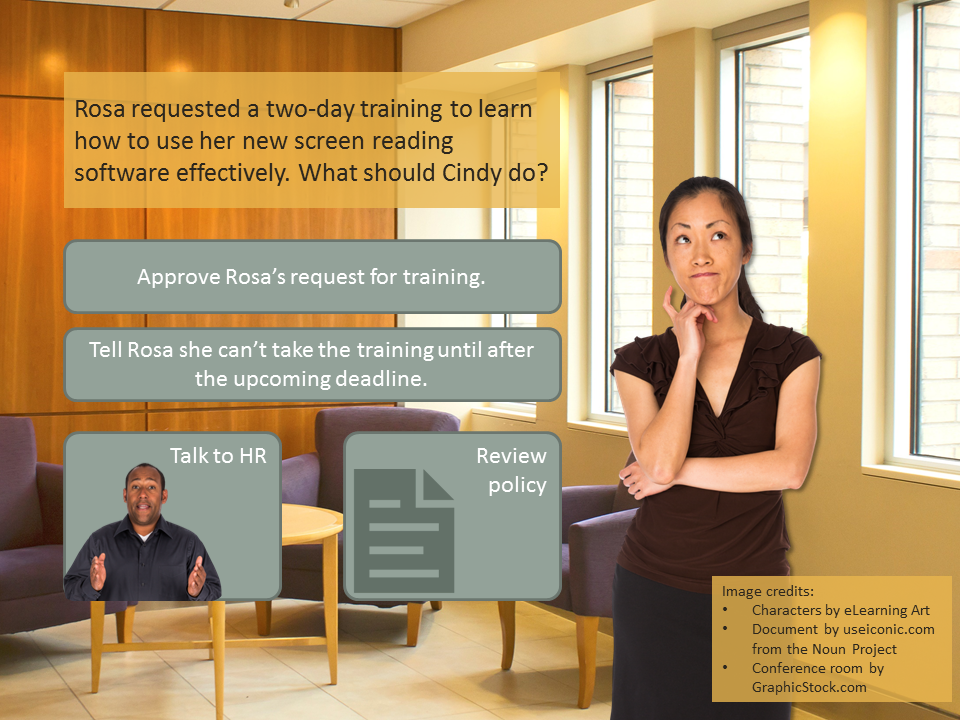What’s Your Character’s Goal?
Author: Christy Tucker
Go to Source
In a scenario for learning, the main character’s goal drives the story. All of the action and decisions in the scenario move you closer or further from that goal.
This is one of the critical elements I mentioned in Protagonists Should Be Like Your Learners:
- Protagonist or main character
- That character’s goal
- The challenges that character faces
Begin with the end in mind
This might seem counter-intuitive; we usually start writing at the beginning of a story. It’s more natural to start writing with “Once upon a time…” than “…happily every after.”
For learning scenarios, this is exactly what we need though. How will your scenario end? What do you want the character to do at the end of your story? How will it conclude?
It might help to think of the conclusion of your story in relation to your learning objectives.
- What do your learners need to be able to do at the end of the training?
- What skills do they need to demonstrate?
- What does successful performance look like?
Successful performance is the goal or conclusion of the story. In a branching scenario, meeting that goal is one of several endings to the story.
Align learning objectives to character goals
As an example, say one objective is for learners to “Provide reasonable accommodations for employees when requested, following company procedures and meeting legal requirements.” What does that really mean for managers? Think about the business need. A manager’s goal isn’t really to provide the reasonable accommodation for a disability. Their big goal is to help their team be productive and successful. That’s the driving motivation.
Goals may be hidden

You might not ever explicitly state that goal. In fact, it’s probably better if you don’t. It can sound a bit stiff and artificial if they do. Most of the time, people don’t cheerfully voice their goals like Cindy in the above image.

Instead of telling your learners the goal directly, try to show that goal through their actions, dialog, and concerns. Cindy, the manager, still has the same motivation and goal here. She wants her team to be productive and successful. She doesn’t say it directly though. Instead of telling you her goal directly, she’s showing you her goal through dialog with a VP. In this case, there’s a more specific goal for a project.

You might not even show the goal as clearly as in that dialog. It might only be revealed in the decisions, your characters make. It’s easy to see how a manager who is worried about a deadline might decline to give an employee time for training. However, if that training on assistive technology will help the employee perform better, it would actually help the team.
Primary goals and secondary goals
Cindy’s primary goal is helping her team be successful so they can meet their deadline. That goal is still pretty far removed from the learning objective though. I’ll keep that primary motivation in mind while I write her character, but I need her to have a secondary goal that ties to the course.
In this case, her secondary goal might be to provide reasonable accommodations for her team so they can keep working effectively. She might have an additional secondary goal of following HR policies so she doesn’t get in trouble. I wouldn’t say that goal directly in the scenario, but the choices she makes (like consulting HR for help) would reflect that goal. In the last example above, delaying Rosa’s training would violate HR policy. The consequences for making that choice would show how she didn’t achieve her goals.
Thinking about your character’s goal and motivation makes them more realistic, and it helps keep your scenarios moving forward towards those goals.
Want to learn more?
Check out all my posts on storytelling and scenarios.
Image credits
- Characters by eLearning Art
- Office backgrounds by Storyblocks
Originally published 5/17/2016. Updated 1/23/2020.
The post What’s Your Character’s Goal? appeared first on Experiencing eLearning.
